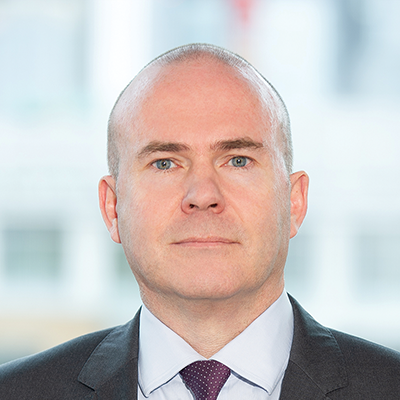High Yield: Liquidity Abounds, But What Lies Ahead?
Policymakers have injected a great deal of liquidity into the capital markets to counter the initial shock from COVID-19, and high yield asset classes have rallied significantly as a result. Central banks made clear their intentions to support the markets through a number of unprecedented and coordinated programs. In the U.S., where the Federal Reserve announced plans to purchase fallen angels and shares in high yield ETFs, high yield bonds and loans ended the quarter in positive territory, returning 9.70% and 9.71%, respectively. In Europe, loans led the positive performance, returning 12.95% in the quarter, followed by bonds, which were up 11.05%.1
FIGURE 1: U.S. AND EUROPEAN SPREADS (HIGH YIELD BONDS VS. LOANS)

Source: BAML, Credit Suisse. As of June 30, 2020.
The ample liquidity from policymakers also opened the markets to most high yield issuers—even those in sectors most directly affected by COVID and the global lockdown. Issuers in industries like travel & leisure, entertainment and retail, for instance, have for the most part been able to successfully access additional capital—and we believe many are in a position to experience a strong recovery when the pandemic begins to recede. That said, given the heightened uncertainty around economic growth and corporate earnings, investors are understandably asking for better economics and controls. As a result, many companies—including well-known names like Carnival Cruise Line and American Airlines—are issuing senior secured bonds, which are higher up in the capital structure than unsecured bonds and backed by issuer collateral. Indeed, secured bond issuance has increased notably in recent weeks, accounting for about a third of total issuance in the U.S. and roughly two-thirds of total European issuance.2
Largely a result of issuers being able to access the markets, default expectations are far less severe than they were a few months ago. While default forecasts at the height of the volatility were, by some estimates, in the high double digits, our expectations today are significantly lower—and we believe defaults will be concentrated in two main areas. The first includes companies that were perceived as high risk heading into the crisis. Many of these companies may have already been headed for default or restructuring, though this event has likely accelerated the process. Businesses that were experiencing secular challenges fall into this category—retail companies like J. Crew, Neiman Marcus, and J.C. Penny, for instance. We may also see defaults rise among companies that were on an improving trajectory prior to the pandemic, but that are in industries that have all but shut down as a result of the lockdown conditions. Hertz is a prime example.
Downgrade expectations have also improved. Ratings agencies initiated a wave of downgrades early on when the pandemic hit, but the pace of the downgrades has since slowed—easing some of the technical selling pressure that existed across the markets in March and April. To be sure, we have seen a number of fallen angels come into the high yield market since the onset of COVID—around $200 billion of debt has been downgraded from investment grade to high yield, including well-known names like Ford and Occidental Petroleum. But in our view, and helped by the Fed’s purchasing program, the high yield market has been able to absorb these in an orderly fashion.
The Opportunities Ahead
In an environment where uncertainty still exists, and further volatility is likely a given, we see benefits to moving higher up in the capital structure and considering secured assets. Senior secured bonds are generally twice covered by the value of the business that is pledged to them. This means that if an issuing company defaults, senior secured lenders are in a favorable position relative to unsecured creditors to drive a debt restructuring, and in some instances take ownership of the company—which has led to strong recoveries over time.
We also see attractive opportunities outside of traditional high yield. Collateralized loan obligations (CLOs), for instance, can offer an opportunity to pick up meaningful incremental yield relative to traditional bonds and loans, and offer the added benefits of diversification and enhanced structural protection. Emerging markets corporate debt, too, can present opportunities—and many EM corporate issuers have performed reasonably well through this challenging period, and appear well-positioned to withstand future headwinds.
As we look across the markets today, most high yield issuers appear to have the liquidity necessary to bridge themselves through the initial shock from the pandemic. However, one big question going forward is which companies will be able to manage higher debt levels, particularly if confronted with a weaker global economy once the pandemic recedes. Inevitably, some will have a harder time managing than others—and as some issuers undergo restructurings or other stressed situations, there may be opportunities for distressed debt managers to buy assets at discounted prices because of technical selling pressure. But experience in this space matters, and it can be advantageous to partner with a manager that has the ability and breadth to track a credit through its life cycle—from the time of issue until, if ever, it encounters a distressed situation.
Ultimately, we don’t know if the worst of the coronavirus crisis is behind us or if we have a ways to go. But the economy and markets will recover—albeit at varying paces—and active management, combined with a steadfast focus on corporate fundamentals, will be key to capitalizing on the resulting upside.
1. Sources: BAML U.S. Non-Financial High Yield Index; Credit Suisse Leveraged Loan Index; Credit Suisse Western European Leveraged Loan Index; BAML European Currency Non-Financial High Yield Index. As of June 30, 2020.
2. Source: S&P LCD. As of May 31, 2020.





